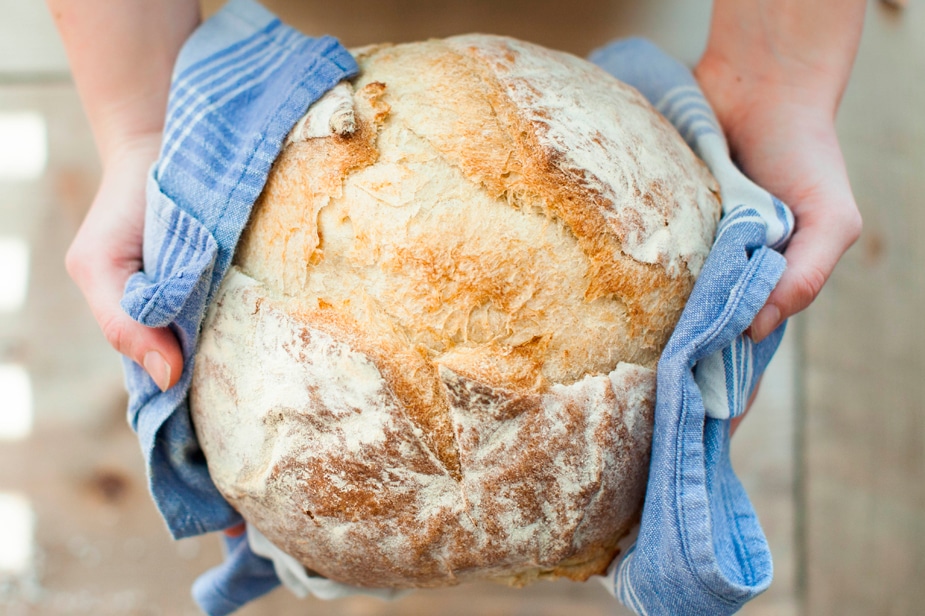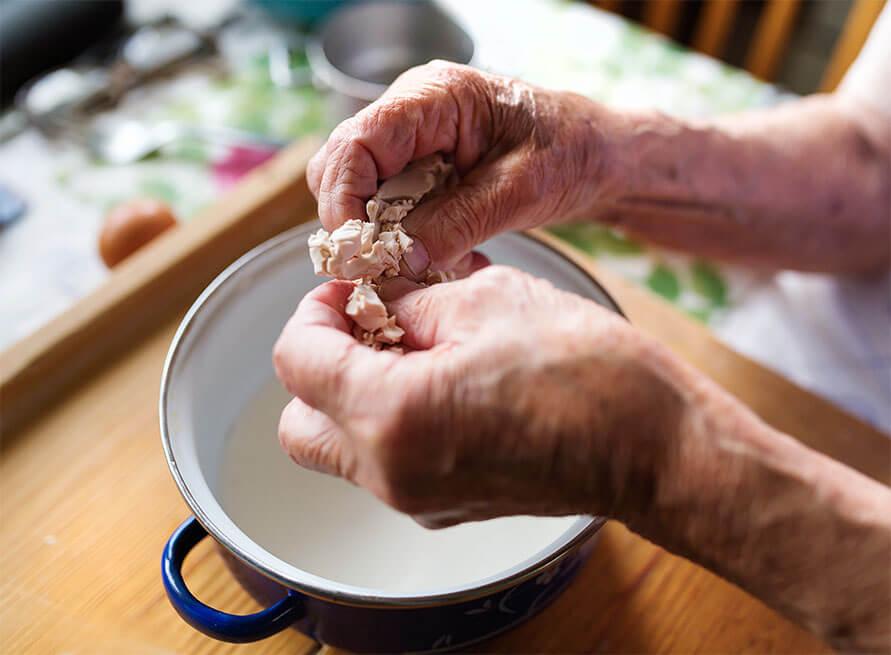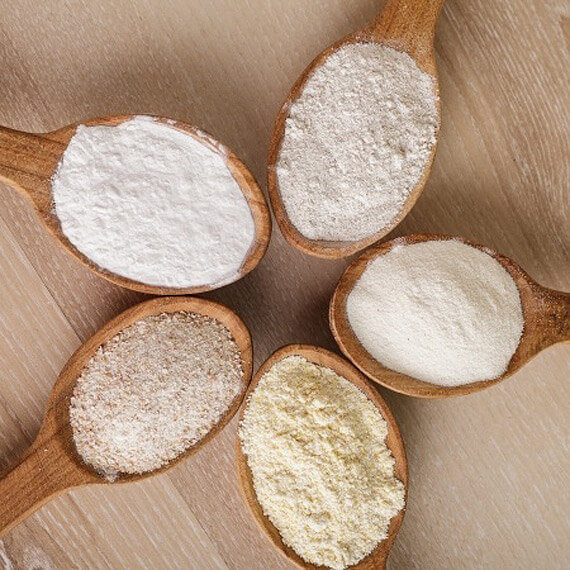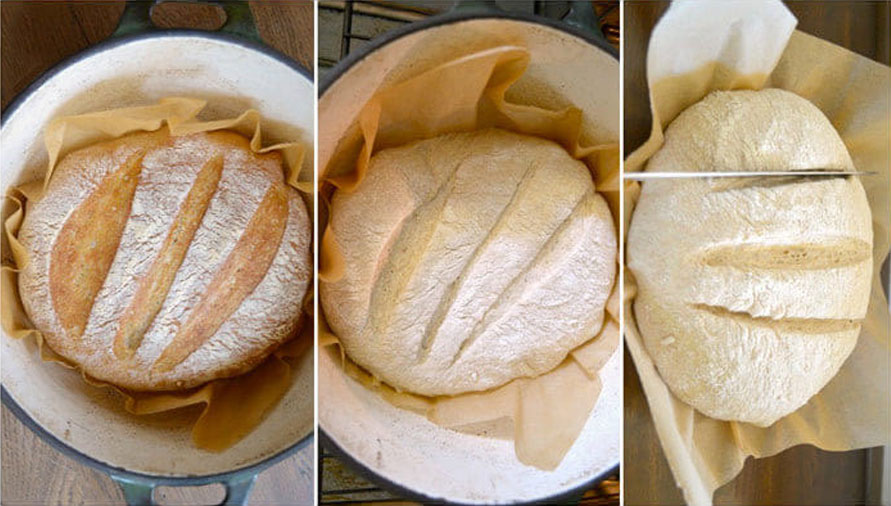If you’ve always wanted to know how to make homemade bread but never dared, today is the day. We’re going to explain step by step how to make homemade bread. The recipe for making bread is very simple and consists of 4 ingredients. Yes, only 4 ingredients, although there could be more if we decide to add some seeds. Or even onion or bacon (but we’ll see that another day). Today we’ll focus on making bread at home, with our domestic oven, and kneading by hand, although this same recipe also works if you have a convection industrial oven and a domestic kneading machine like this one.
How to make homemade bread. Bread recipe
Bread recipe, ingredients and steps.

homemade bread recipe
Ingredients for making bread:
- 500 grams of bread flour or medium-strength flour
- 300-320 grams of water.
- 10 grams of salt (1 teaspoon)
- 10 grams of fresh yeast for bread or 1/3 of powdered yeast (3.3 grams)
Bread recipe steps:
- Mix the flour, yeast, and salt in a large bowl.
- Add the water little by little while mixing with a wooden spoon until the dough begins to form.
- Knead for 10-15 minutes or until it becomes smooth and elastic. If you have a kneading machine, use it instead to save time and effort.
- Cover the dough with a damp cloth and let it rest in a warm place for at least one hour.
- Once the dough has increased in size, knead it again for a few minutes (5 minutes) to remove the accumulated air.
- If you want quick bread, skip step 9.
- Store it in the refrigerator for a second fermentation of 24 hours (this way it will self-knead and ferment, which will give you a more authentic flavor).
- After 24 hours, take it out of the refrigerator and leave it for 20 minutes to come to room temperature.
- Shape it in the form you prefer (a loaf, a baguette, or a roll).
- Preheat the oven to maximum 240-250ºC and leave the tray inside.
- Place the dough in a bread pan or inside the bowl and let it rest for another 30-45 minutes.
- Make a cut on the surface of the bread so that it expands during baking.
- Bake the bread for 40-45 minutes or until it’s golden and sounds hollow when you tap it on the bottom.
- Let the bread cool before cutting it and you can enjoy it.
Video on how to make homemade bread
Everything you need to know to make homemade bread
Next, we’re going to explain in much more detail everything you need to know to make good bread at home.
- The ingredients and their trick, to make half-kilo, one-kilo breads, or the amount of bread you want.
- We’ll explain the different types of flour for making bread.
- We’ll explain how to knead like a real baker.
- You’ll know how bread fermentation works.
- How to make bread cuts and why they’re important.
- And how to bake bread correctly (it consists of several phases).
Ingredients for making homemade bread:

ingredients for making bread
- 500 grams of bread flour or medium-strength flour
- 300-320 grams of water.
- 10 grams of salt (1 teaspoon)
- 10 grams of fresh yeast for bread. or 1/3 of powdered yeast (3.3 grams)
The Percentage Trick for making homemade bread:
Percentages of ingredients for making bread would be: If we want to make a 1kg bread we’ll need:
- 100% of flour (1kg)
- 60% of water (600gr)
- 2% of fresh yeast or 1/3 part of fresh if it’s instant dry. (20 grams fresh yeast or 6.7 grams dry)
- 2% of salt. (20 grams)
TOTAL: 1640 grams
Of which after baking we can lose between 10 and 15% so we would end up with a homemade bread of between 1,394 gr. and 1,476 gr.
The water percentages for bread can also vary, as depending on the flour and the type of bread we want to make, we’ll need more or less: ✔What types of bread can be made?
- Castilian bread with tight crumb: 50-55%.
- Rustic bread: 60%.
- Baguettes: 65%.
- Paleo Bread: paleo diet
- Breads with large holes: 65-70%.
- Ciabatta: 80%.
Type of flour for making homemade bread.

Types of flour
| Weak flours (for sponge cakes, profiteroles, cakes, shortcrust pastry, cookies…) also called T45 | 8-up to 10 max. protein %. |
| Medium strength or bread-making flours. Also known as T55 | 10-11.5 % protein. |
| Strong flours and very strong (brioches, doughs with a lot of fat and a lot of sugar). Also known as T65. | 12-13-14% protein. |
To give us an idea of what we can find in different supermarkets and according to flour brands, the following list shows the protein percentages of each:
- Maizena Corn Flour.- Proteins 0.4%
- Mercadona Flour For Cakes.- Proteins 5.94%
- Aragonesa Corn Flour.- Proteins 7.2%
- Aragonesa Whole Wheat Flour.- Proteins 8.89%
- Consum Pastry Flour.- Proteins 9%
- El Corte Ingles Flour.- Proteins 9%
- Royal Rebocina Flour.-Proteins 9.3%
- Nomen Flour.-Proteins 9.5%
- Dia Flour.- Proteins 10%
- Carrefour Flour.- Proteins 10%
- Fabulo Del Plus Flour (Village Bread).-Proteins 10%
- Carrefour Whole Wheat Flour.-Proteins 10%
- Aragonesa Special Pastry Flour.-Proteins 10.32%
- Mercadona Pastry Flour.- Proteins 10.32%
- Harimsa Organic Flour.-Proteins 10.50%
- Harimsa Whole Wheat Cake Flour.-Proteins 10.90%
- Aragonesa Strong Flour –
- Gallo Flour.-Proteins 11%
- Auchan Flour from Alcampo.-Proteins 11%
- Harimsa Special Pizza Flour.-Proteins 11.1%
- Naturasi Organic Flour.-Proteins 11.5%
- Fabulo Del Plus Flour (Seed Bread).-Proteins 11.8%
- Allinson Strong Flour.-Proteins 12.1%
- Harimsa Flour.-Proteins 13.10%
- Carrefour Spelt Flour.-Proteins 13.30%
- Allinson Very Strong Flour.-Proteins 13.9%
- Alteza Flour.- Proteins 14%
The strength of a flour is given by the gluten content it has, the more gluten, the stronger the flour. Gluten is a protein. Of the total amount of proteins a flour has, gluten represents between 80% and 85% of the total.
Homemade Bread Recipe:

homemade bread recipe
Once we have all the ingredients, we can proceed to prepare our homemade bread. There are many ways to make homemade bread, but we’ve stuck with the one that has given us the best result. Good texture, good crumb, and a good crust. We incorporate all the ingredients, we can do it by hand or we can do it with a machine, a KitchenAid for example, with the kneading accessory. We decided to put the new KitchenAid Artisan stand mixer to the test.
Before we dive in, here are a few products from our store that can help you with your homemade bread recipe and preparation:
1. Mixing:

Video on How to Make Bread: Mixing and Kneading
In the following video, you can watch the bread-making process by a French master baker.
2. First Fermentation of Homemade Bread Dough:

3. Kneading.

“`html
4. Second Fermentation and Self-Kneading.
- Now it’s time for the yeast to knead the dough on its own. To do this, we cover the bowl well with plastic wrap to keep air out and prevent drying, and we store it in the refrigerator for 12 to 24 hours. During this time, the yeast will naturally knead our homemade bread dough.
5. Dividing and Shaping the Homemade Bread.
- After our second fermentation, which lasts between 12 and 24 hours, we’ll see that our dough has grown considerably, nearly doubling in size.
- Since the dough will be quite cold, we need to let it warm up a bit. Flour the surface, place the dough on top, and cover it with a damp cloth for one hour.
- When there’s half an hour left, preheat the oven to its maximum power, 250–240ºC, or as high as your oven goes. And leave the baking sheet inside.
- If you have another baking sheet, place it on the lower rack beneath the one where we’ll place our bread.
- Now, without handling the dough too much, we can shape it.
- If you followed the recipe measurements, you can make a single large loaf, whether it’s a round loaf, rustic bread, or a baguette-style loaf.
6. Scoring the Homemade Bread Loaf:
Types of scoring for homemade bread
Scoring is not just an aesthetic element; it is also a small art in bread making, homemade or not. Scoring tells us more than we think.
But why do we score the bread?
The generation of gases inside the loaf causes these gases to try to escape, expanding the dough. If we didn’t make these cuts, the dough could burst open anywhere, resulting in a pretty unattractive or odd-looking bread.
- With the cut, we can control this bursting and, at the same time, personalize our homemade loaves.
- Experiment with different scores: top, side, crisscross, or with different angles.
- In general, make shallow cuts.
- You can watch this video showing different types of scores.
“`html
Baking.
- Place the bread on parchment paper, and dust the top of the homemade bread with flour.
- Remember that the oven is set to 250ºC with two trays inside, the lower tray will help to generate steam inside the oven, which will result in better bread, as it could dry out excessively at such high temperatures.
- To bake, open the oven and slide the bread onto the upper tray (it should be positioned at mid-height). We have Bakery ovens for bakeries, bars, restaurants, and cafes available in our store.
- Close the door quickly to prevent the temperature from dropping, then pour a glass of water into the lower tray.
- This heat burst from the hot tray and the 250ºC temperature, combined with the steam, will give a powerful boost to our bread, and within 7-10 minutes, we will see that our bread rises quickly.
- After these 7-10 minutes, turn off the oven and let the bread rest for 10 minutes. Your oven will now be working like a stone oven, providing strong but controlled heat.
- After 10 minutes, turn the oven back on and lower the temperature to 200ºC for about 20 minutes. Always keep an eye on the bread to prevent it from burning on top. Every oven works differently, so it’s important to monitor how your oven handles the bread during this first bake.
- After these 20 minutes, more or less, your homemade bread will be ready.
- If you like a hard and crunchy crust, you can turn off the oven now and leave the bread in for another 10 minutes.
Making Bread with a Bread Maker
- This is another option that might save you time, although you may miss out on the best part of making homemade bread, which is learning how to prepare it and understanding the process.
- Manufacturers have created bread makers, simple appliances that make bread-making easier. Buy Bread Maker.
- One of the best-performing bread makers that we know works wonderfully is the Moulinex Home Baguette.
- Another great bread maker with excellent value for money is the Moulinex Pain Doré OW2101.
Tips for Making Homemade Bread.
- When you take the bread out of the oven, flip it over and give it a few taps on the bottom. If it makes a hollow sound, it means that your bread is perfectly baked. If you followed the instructions, it should be just right.
- Once it’s ready, place the bread on a cooling rack, preferably not metal, and let it cool. We know it’s hard to wait, but try to hold off for at least an hour or two, depending on the temperature, before tasting your first homemade bread.
- Use good flour, and most importantly, practice. Make bread with different types of flour, mix them, experiment. You’ll find that depending on the ratios, the bread will acquire different flavors.
Buy Flour and Other Bread-Making Tools.
As mentioned before, flour is essential to making good bread, whether homemade or not. So I recommend buying quality flour. While supermarket flour isn’t bad, it’s better to look for high-quality flour. You’ll notice the difference in everything, from kneading to fermentation and especially in flavor.
How to Make Homemade Bread Recipe.
- Freshly baked bread can be incredibly tempting—who doesn’t love it fresh from the oven? But if you wait, it will be much better—richer, more consistent, more flavorful. Trust me, it’s worth the wait.
- One of my favorite ways to enjoy homemade bread is to lightly toast a slice. You’ll find a wide variety of toasters on the market. Though it may seem insignificant, a good toaster that works well is key to achieving a uniform toast, without burnt edges or untoasted areas.
- Once toasted, grab a good tomato, rub it on the bread, add a bit of salt, and drizzle with quality olive oil—the better the quality, the better the taste.
- I prefer it just like that, though you can pair it with whatever you like. On our Instagram and Pinterest, you’ll find plenty of inspiring photos.
“`html
And finally, the most important thing when making homemade bread.
If you enjoyed this article, share it!
Frequently Asked Questions about Making Homemade Bread.
- 100% flour (1kg)
- 60% water (600g)
- 2% fresh yeast or 1/3 of that if using dry instant yeast (20g fresh yeast or 6.7g dry yeast)
- 2% salt (20g)
Frequently Asked Questions about Homemade Bread.
What are the ingredients for making bread?
For a total of 1.5 kg of bread, you will need the following ingredients:
- 100% flour (1kg)
- 60% water (600g)
- 2% fresh yeast or 1/3 of that if using dry instant yeast (20g fresh yeast or 6.7g dry yeast)
- 2% salt (20g)
At what temperature should I bake homemade bread?
Bake the bread as follows:
- 10 minutes at 250°C
- 10 minutes at 100°C
- 30 minutes at 200°C
- Finally, 10 minutes with the oven turned off.
How can I make bread without yeast?
To make bread without yeast, you will need to prepare a sourdough starter. The ingredients for this are:
- 50g of whole wheat or rye flour
- 50g of tap water at room temperature
“`







Leave A Comment